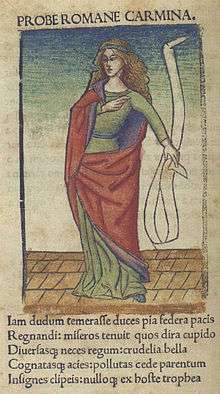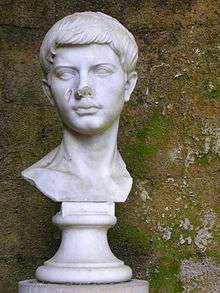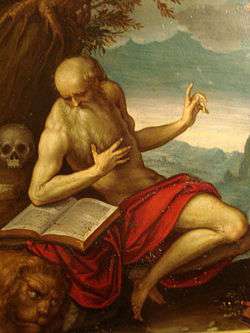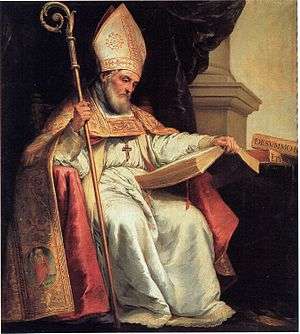Cento vergilianus de laudibus Christi

Cento vergilianus de laudibus Christi (Latin: [kɛn.toː wɛr.ɡɪl.ɪ.aː.nʊs deː laʊ̯.dɪ.bʊs kʰrɪs.tiː]; A Virgilian Cento Concerning the Glory of Christ), also known as De laudibus Christi and Cento Probae, is the title of a fourth century AD poem of the Roman Empire. It was arranged by Faltonia Betitia Proba c. AD 350–360 following the author's conversion to Christianity. A cento is a poetical work wholly composed of verses or passages taken from other authors, disposed in a new form or order. This poem reworks verses extracted from the works of Virgil, one of the greatest poets of Latin literature, and details several stories from the Old and New Testament of the Christian Bible, with the crux of the work focusing on the story of Jesus Christ.
The impetus for its creation is unknown, although several hypotheses have been put forward, namely that Proba was trying to circumvent a law put in place by the Roman Emperor Julian that forbade Christians from teaching classical Greek and Latin literature which they themselves did not believe in, or that Proba was responding to and rebutting the rather unflattering and demonizing descriptions of Jesus put forth by Julian in his works Caesares and Contra Galilaeos. The work was circulated heavily, although it was deemed apocryphal by Pope Gelasius I. Furthermore, many scholars believe that St. Jerome disliked the work. However, the likes of Isidore of Seville, Petrarch, and Giovanni Boccaccio praised Proba. In the 19th and 20th centuries, the work was criticized for being of poor quality, but recently, scholars have taken a renewed interest in it.
Origin and style

Faltonia Betitia Proba, the cento's author, was born around AD 322. Proba was married to Clodius Celsinus Adelphius, who was a prefect of Rome in AD 351.[1] Proba was a noted poet, and her first work (which is now lost) was called the Constantini bellum adversus Magnentium; this poem dealt with the war between Roman Emperor Constantius II and the usurper Magnentius.[1][2] At some point in her life, Proba converted from paganism to Christianity. De laudibus Christi, in turn, was written following her conversion, probably sometime c.AD 350–360,[3][4] and was an attempt by the poet to “turn away from battle and slayings in order to write holy things.”[5]

The majority of the work takes the form of a Virgilian cento, or a patchwork of verses extracted from several works of the Roman poet Virgil (although the work's proemium and invocation section is composed of several original lines of Latin, in addition to lines borrowed from or alluding to Virgil, the Silver Age poet Lucan, and the 4th century poet Juvencus).[4][6] This creative choice on the part of Proba seems to have been made for two reasons. First, Virgil was an extremely influential poet, having been commissioned by the first Roman emperor Caesar Augustus to write the epic poem the Aeneid. Virgil’s influence was felt well in to late antiquity, and was imitated by others, such as Juvencus and Prudentius.[7] The respect that was given to Virgil eventually manifested in the form of the aforementioned centos, which reached their acme in the fourth century AD.[8] Second, Virgil was often appropriated by Christian authors, due to a popular interpretation of his fourth Eclogue, which many believed to be a prophecy concerning the birth of Jesus.[9]
Bernice Kaczynski writes, “Scholars have seen traces of Proba’s own character in her emphasis on the beauty of the natural world, readily apparent in her account of the creation.”[5] Kaczynski also argues that the cento suggests that she had a high regard for “domestic matters, for marriage and the family, for marital devotion and [for] filial piety”.[5] Conversely, Proba seems to de-emphasize the importance of ascetism, as neither virginity or poverty is a recurring theme in the work. In fact, in regards to the latter, Proba reinterprets many of the New Testament episodes that featuring Jesus urging his followers to eschew wealth into passages that merely suggest that Christians should share their wealth with their family. Such changes index Proba’s historical context and her socio-economic position, and the class expectations thereof.[5]
Contents
Summary
"But baptised, like the blest, in the Castalian font—
I, who in my thirst have drunk libations of the Light—
now begin my song: be at my side, Lord, set my thoughts
straight, as I tell how Virgil sang the offices of Christ."
—De laudibus Christi, ll. 20–23, translated by Josephine Balmer[10]
The cento's 694 lines are divided into a proemium with invocation (lines 1–55), episodes from the Old Testament (Genesis, lines 56–318; Exodus, lines 319–332), episodes from the New Testament (The Gospels, lines 333–686), and an epilogue (lines 687–694).[11] At the beginning of the poem, Proba references her earlier poetry, before rejecting it in the name of Christ. She then describes herself as a prophet, calls upon both God and the Holy Spirit (scorning the help of the Muses), and announces her intentions to record the story of Jesus.[12][13] At the conclusion of the poem's invocation, Proba states her poem's main purpose: to "tell how Virgil sang the offices of Christ."[14]
The Old Testament episodes concern the creation of the world, the Fall of Man, the Great Flood, and the Exodus out of Egypt.[15] Proba's presentation of Creation—which is largely based on rewordings of Virgil's Georgics—reorganizes what is found in Genesis to more closely align the biblical account with then-contemporary Greco-Roman beliefs concerning the origin of the world.[16] Consequently, "some stages of creation are abbreviated while others are amplified or even transposed" to "avoid repetitions and contradictory elements", such as the double creation of man (i.e. Genesis 1:25–27 and Genesis 2:18–19).[17] During the presentation of the events leading to the Fall of Man, Eve's actions are largely based around the story of Dido (from Book IV, Aen.).[18] The Serpent is described using lines describing Laocoön's death (from Book II, Aen.), as well as the snake sent by the fury Alecto to enrage Amata (from Book VII, Aen.)[19] To describe human life after the Fall, Proba makes heavy use of the first two books of the Georgics, specifically the sections that discuss the Iron Age of Man;[20] in this way, Proba is able to connect the Greco-Roman concept of the "Ages of Man" with the Christian concept of the "Fall of Man".[21]
Directly after the Old Testament stories, Proba once again appeals to God, before discussing the birth of Jesus.[22] The following New Testament episodes then deal with the life of Jesus, his crucifixion, and the coming of the Holy Spirit.[15][23] While Jesus is often described using language befitting a hero (see below),[24] Mary is described using lines that originally related to Venus and Dido.[25] Curiously, Joseph is omitted entirely.[26] Furthermore, Mary's role has been interpreted in various ways by scholars. Some, such as Culhead and Kate Cooper see Mary as a "heroic protagonist" and a materfamilias, who is brave and intelligent.[25][27] Others, like Elizabeth Clark and Diane Hatch, argue that Proba's depiction of Mary is decidedly maternal. Still others, such as Stratis Kyriakidis, argue the opposite: that the character lacks any female attributes and is thus "impersonal".[25] The Sermon on the Mount is notable in that it begins by borrowing the Sibyl of Cumae's description of punishment for the unrighteous (from Book VI, Aen.). This has led some scholars to contend that this portion of De laudibus Christi is the first account of Hell in Christian poetry.[28] Christ's deeds are telescoped down to three events: Jesus calming the sea, walking on water, and calling his first disciples.[29] Proba conveys the Crucifixion by using, most notably, several lines describing Hadean punishment (from Book VI, Aen.), among others.[30] Following Christ's death, Proba uses various lines that reference the erotic love between Dido and Aeneas, which are transformed to signify "the sacred love of Christ and his followers."[31] After Christ is resurrected, he addresses his followers, describing the world to come via the prophecy delivered by Celaeno and the Oracle of Delos (from Book III, Aen.).[32] Finally, the ascension, is represented using language that originally described Mercury.[33]
Characterization of Jesus
Due to the heavy borrowing from Virgil, Proba's Christ is very similar to the Virgilian epic hero,[34] in that he is: seeking a goal that is greater than merely his human happiness, initiating a realm in which there would exist "dominion without end", and projecting an aura of divinity.[35] Proba's entire purpose, argue Clark and Hatch, was therefore to "imbue the Christ with heroic virtues" akin to the Virgilian hero.[36] She does this in three major ways. First, Proba physically describes Jesus as being remarkably beautiful,[37] as well as having "a magnificent and commanding presence" similar to Aeneas.[38] Second, Proba recasts the entire crucifixion episode so that Jesus does not go meekly to his death, but rather lashes out angrily at his persecutors.[39] Proba's reconfiguration of Jesus's crucifixion is therefore more in line with Aeneas' "vengeful action" against Turnus at the end of book twelve of the Aeneid. Finally, Proba transfers unto Jesus parts of the various prophecies scattered throughout the Aeneid that detail the future glory of Rome via the progeny of Aeneas, recasting these oracular episodes in a Christian light.[40]
Proba's motivation
R. P. H. Green argues that Proba’s work was a reaction to Roman Emperor Julian’s law that forbade Christian from teaching classical Greek and Latin mythological literature in which they themselves did not believe.[41] Proba’s goal, Green argues, was to present “Vergil without [pagan] gods, and [thus] a Vergil no longer vulnerable to Christian criticism.”[42] In this way, a Christian teacher could use this text to discuss Virgil without compromising their moral integrity.[42] Another related hypothesis later emerged, put forth by scholar Aurelio Amatucci, which suggested that Proba had created the cento in order to teach her children stories from the Bible.[43] However, there is no direct evidence implying that the work was created by Proba to be a teaching tool.[44][45][46] Clark and Hatch postulate that the distinctly Virgilian nature of Jesus in the cento could very well have been Proba's attempt at responding to and rebutting the rather unflattering and demonizing descriptions of Jesus put forth by Julian in his works Caesares and Contra Galilaeos. Clark and Hatch, however, concede that while the hypothesis is intriguing, it is largely unfalsifiable due to lack of information about Proba, the date of the cento's creation, and her intentions.[35][38]
Reception
Around the time of its creation, Proba’s cento was immensely popular; it is attested not only in manuscript records, but also the records of claustral libraries. The work was also heavily used in schools alongside St. Augustine’s De Doctrina Christiana (with Proba’s work often eclipsing Augustine’s in popularity). Cătălina Mărmureanu et al. argue that the work was so popular because of its accessible Virgilian style, and because Proba presented herself as “meek” female, which appealed to the “misogynistic views of the general public”.[45]

The work did have its early detractors. It is believed by many that Jerome criticized this work, for in a letter written from Bethlehem to Paulinus of Nola in which he criticized Virgilian centos,[47] he warned against following an "old chatterbox" (garrula anus), and those who think of calling "the Christless Maro [i.e. Virgil] a Christian" (non [...] Maronem sine Christo possimus dicere Christianum).[22][44][48][nb 1] According to historian James Westfall Thompson, Jerome “strongly inveighed against this method of destroying the sense of a pagan author [and] his love of the classics and his Christian piety were alike offended.”[52][nb 2] Another critic of the poem was Pope Gelasius I (492–496), who declared the De laudibus Christi apocryphal, and he added it to his decretal "Of books to be received and not to be received".[54][55] This meant that while the poem was not considered heretical, it was forbidden for it to be read in public.[15]
Despite these criticisms, Roman Emperor Arcadius (AD 395–408) received a copy of the poem, and his version contains a fifteen line dedication noting that Proba's work is "Maro changed for the better in a sacred meaning” (Maronem mutatum in melius divino [...] sensu).[56] It was also presented to Aelia Eudocia, the wife of Emperor Theodosius II (AD 408–450).[57] During Late Antiquity, Archbishop Isidore of Seville (AD 560–636) wrote highly of Proba, calling her the “only woman among the men of the church” (Proba [...] femina inter viros ecclesiasticos [...] posita sola), and while he argued that the work was not worth much praise, her ingenuity in regards to its creation indeed was (Cuius quidem non miramur studium sed laudamus ingenium).[58][59] In the Middle Ages, Proba and her work would go on to be praised as examples of learnedness. Petrarch implicitly referenced De laudibus Christi in a letter discussing female geniuses, and in AD 1374 Giovanni Boccaccio included Proba on his list of famous women.[60] In AD 1472, the poem was first printed; this means that Faltonia Betitia Proba may very well have been the first female author to have her work duplicated via the printing press.[61]
Scholarship in the 19th and 20th centuries was much more critical of the work,[62] with William Smith's Dictionary of Greek and Roman Biography and Mythology referring to the poem as "trash" worthy of "no praise".[63] It was also used by classicists and philologists of the era as an example of "late antiquity's 'poverty of ideas'".[35] Despite the disgust directed at the work during the 19th and 20th centuries, scholars have have taken a renewed interest in the poem,[64] with many seeing it as an interesting piece of literature worthy of study.[nb 3] Exemplifying such an opinion, Cullhed considers the work "of considerable historical and cultural importance [for] it belongs to the small number of ancient texts with a female author and stands out as one of our earliest extant Christian Latin poems."[65]
The first English work dedicated in its entirety to Proba and her poem was the 2015 monograph Proba the Prophet, written by Cullhed.[66]
Authorship controversy

The work is traditionally ascribed to Faltonia Betitia Proba, based largely on the assertion of Isidore, who notes that the work was the product of a woman named Proba who was the wife of a man named Adelphus (Proba, uxor Adelphi, centonem ex Vergilio [...] expressit).[67] However, classicist and medievalist Danuta Shanzer argued that the work was not actually created by Faltonia Betitia Proba, but rather her granddaughter, Anicia Faltonia Proba, a noblewoman who lived at the end of the fourth and beginning of the fifth centuries AD.[3] Shanzer and others who agree with her developed several arguments as to why they believed that the work was not Faltonia Betitia Proba’s. First, they argue that lines 13–17 of De laudibus Christi bear a resemblance to lines 20–24 of the later poem Carmen contra paganos which is purported to have been penned after Faltonia Betitia Proba's death.[3][68] Second, they believe that the poem must have been written after AD 387, because it alludes to a debate about the date of Easter, which only took place in 387. Third, they see Jerome’s allusion to the poem (discussed above) as a reference to a living individual (i.e. Anicia Proba). Fourth, they contend that Faltonia Betitia Proba had actually died during the war between Magnentius and Consantius, a war alluded to in the invocation of De laudibus Christi. Fifth and finally, they argue that Anicia Proba must have written the work since the author is referred to as “mother of the Anicians” in a later manuscript, as well as the “eminent Roman Mistress” in another; these are titles only Anicia Proba would have received.[68]
Sigrid Cullhed, in her 2015 book Proba the Prophet, collects various counterpoints to Shanzer et al.’s claims. First, Cullhed disputes the first argument, noting that “there are no ‘grounds for determining priority’” of the lines.[68] In regards to the second point, Cullhed notes that the supposed reference to the AD 387 debate about Easter could have easily referred to an earlier dispute.[68] Countering the third point, Cullhed notes out that many other scholars feel that Jerome would have never insulted Anicia Proba since he praised her as “the richest, noblest and most powerful woman in Rome” in another letter (this opinion is reiterated by Green).[3][68] In regards to the fourth argument, Cullhed notes that Faltonia Betitia Proba’s supposed death in AD 351 may very well be unfounded. Opposing the fifth point, Cullhed argues that the titles used to refer to the author could have been inserted after the fact, sometime in the Middle Ages. Finally, Cullhed brings forth new evidence, arguing that if Anicia Proba had penned De laudibus Christi, it is likely that the Latin poet Claudian would have mentioned her poetic skills in his panegyric that celebrated the joint consulship of Anicia Proba's two sons, Anicius Hermogenianus Olybrius and Anicius Probinus in AD 395.[68] Cullhed summarizes her argument by saying: “The evidence for discrediting Isidore’s attribution [of Faltonia Betitia Proba as the cento's author] is not sufficient, and so, I will assume that the cento was written in the mid-fourth century by Faltonia Betitia Proba.”[68] Likewise, Karl Schenkl argues that scholars should accept the testimony of Isidore, who clearly attributes De laudibus Christi to Faltonia Betitia Proba.[13] The general consensus of classicists and scholars today is that De laudibus Christi was indeed arranged by Faltonia Betitia Proba.[69]
See also
- Interpretatio Christiana, the adaptation of non-Christian elements of culture or historical facts to the worldview of Christianity
Footnotes
- ↑ However, Alessia Fassina proposed that the garrula anus referred to by Jerome was actually Melania the Elder,[49] and Sigrid Cullhed hypothesizes that Jerome is not talking about any one person, but rather a type of person not fit to preach the Gospel.[50] With this being said, Cullhed also contends that "the majority of scholars believe that 'this babbling old lady' must refer to none other than Proba".[51]
- ↑ Ironically, in the Medieval period—because Faltonia Betitia Proba was often confused with her granddaughter Anicia Faltonia Proba and because Jerome praised Anicia Proba in a letter to Demetrias—De laudibus Christi was sometimes called "The cento of the illustrious poet Proba Faltonia, approved of by divine Jerome".[53]
- ↑ For instance: Green argues that "a Vergilian cento [i.e. De laudibus Christi] has suffered unjustified neglect from scholars",[3] Kaczynski calls the work "remarkable" and "the most successful Christian" cento,[4] and Cullhed notes that the works "position in the tradition between Vergil and the Bible [...] its radical technique of literary imitation and female author-function [...] renders the reception of the Cento a rewarding field of study."[65]
References
- 1 2 Kaczynski 2013, pp. 131–132.
- ↑ Cullhed 2015, p. 24.
- 1 2 3 4 5 Green 1995, p. 551.
- 1 2 3 Kaczynski 2013, p. 131.
- 1 2 3 4 Kaczynski 2013, p. 132.
- ↑ Cullhed 2015, p. 113.
- ↑ Ziolkowski & Putnam 2008, p. 475.
- ↑ Ziolkowski & Putnam 2008, p. 469.
- ↑ Ziolkowski & Putnam 2008, p. 470.
- ↑ Balmer 1996, p. 111.
- ↑ Cullhed 2015, pp. 113, 190–231.
- ↑ Mărmureanu, Cernescu, and Lixandru 2008, pp. 5–6.
- 1 2 Plant 2004, p. 170.
- ↑ Mărmureanu, Cernescu, and Lixandru 2008, p. 6.
- 1 2 3 Mărmureanu, Cernescu, and Lixandru 2008, p. 5.
- ↑ Cullhed 2015, pp. 138–140.
- ↑ Cullhed 2015, pp. 138, 141–142.
- ↑ Cullhed 2015, pp. 142, 145.
- ↑ Cullhed 2015, p. 151.
- ↑ Cullhed 2015, pp. 154–155.
- ↑ Cullhed 2015, p. 157.
- 1 2 Disse, Dorothy (November 26, 2012). "Proba/Faltonia Betitia Proba (c. 322–c. 370)". InfIonLine.net. Archived from the original on April 3, 2013. Retrieved December 2, 2015.
- ↑ Mărmureanu, Cernescu, and Lixandru 2008, p. 4.
- ↑ Cullhed 2015, pp. 158, 164.
- 1 2 3 Cullhed 2015, pp. 164–165.
- ↑ Cullhed 2015, p. 164.
- ↑ Cooper 2007, pp. 66–67.
- ↑ Cullhed 2015, pp. 169–170.
- ↑ Cullhed 2015, p. 176.
- ↑ Cullhed 2015, p. 181.
- ↑ Cullhed 2015, p. 184.
- ↑ Cullhed 2015, p. 185.
- ↑ Cullhed 2015, p. 186.
- ↑ Cullhed 2015, p. 158.
- 1 2 3 Clark & Hatch 1981, p. 31.
- ↑ Clark & Hatch 1981, p. 36.
- ↑ Clark & Hatch 1981, pp. 33–34.
- 1 2 Clark & Hatch 1981, p. 33.
- ↑ Clark & Hatch 1981, p. 34.
- ↑ Clark & Hatch 1981, p. 35.
- ↑ Green 1995, pp. 555–558.
- 1 2 Green 1995, p. 558.
- ↑ Cullhed 2015, pp. 52–53.
- 1 2 Plant 2004, p. 171.
- 1 2 Mărmureanu, Cernescu, and Lixandru 2008, p. 8.
- ↑ Cullhed 2015, p. 53.
- ↑ Copeland 2016, 357.
- ↑ Green 1995, p. 553.
- ↑ Fassina, Alessia. Una Patrizia Romana al Servizio della Fede: Il Centone Cristiano di Faltonia Betitia Proba (Thesis). Ca' Foscari University of Venice. Retrieved November 24, 2015.
- ↑ Cullhed 2015, p. 58.
- ↑ Cullhed 2015, p. 57.
- ↑ Thompson 1906, p. 650.
- ↑ Cullhed 2015, p. 64.
- ↑ Thompson 1906, pp. 649–650.
- ↑ Mărmureanu, Cernescu, and Lixandru 2008, p. 9.
- ↑ Cullhed 2015, p. 190.
- ↑ Cullhed 2015, p. 59.
- ↑ Jensen 1996, p. 53.
- ↑ Isidore of Seville, De viris illustribus, V.
- ↑ Cullhed 2015, p. 25.
- ↑ "Source Details: The Golden Bough, The Oaken Cross: The Virgilian Cento of Faltonia Betitia Proba". medievalsourcesbibliography.org. Retrieved December 2, 2015.
- ↑ Cullhed 2015, p. 56, 66–67.
- ↑ Smith 1849, p. 134.
- ↑ Kaczynski 2013, p. 133.
- 1 2 Cullhed 2015, p. 6.
- ↑ Cullhed 2015.
- ↑ Isidore of Seville, Etymologiae, I.39.26.
- 1 2 3 4 5 6 7 Cullhed 2015, pp. 22–23.
- ↑ Cullhed 2015, p. 65.
Bibliography
- Balmer, Josephine (1996). Classical Women Poets. Hexham: Bloodaxe Books. ISBN 9781852243425.
- Clark, Elizabeth; Hatch, Diane (1981). "Jesus as Hero in the Vergilian 'Cento' of Faltonia Betitia Proba". Vergilius (27): 31–39. JSTOR 41591857.
- Cooper, Kate (2007). The Fall of the Roman Household. Cambridge, UK: Cambridge University Press. ISBN 9781139469104.
- Copeland, Rita, ed. (2016). The Oxford History of Classical Reception in English Literature: 800-1558, Volume 1. Oxford, UK: Oxford University Press. ISBN 9780199587230.
- Cullhed, Sigrid Schottenius (2015). Proba the Prophet. Leiden: Brill Publishers. ISBN 9789004289482.
- Green, R. P. H. (1995). "Proba's Cento: Its Date, Purpose, and Reception". The Classical Quarterly. 45 (2): 551–563. JSTOR 639543.
- Jensen, Anne (1996). God's Self-Confident Daughters. Louisville, Kentucky: Westminster John Knox Press. ISBN 9780664256722.
- Kaczynski, Bernice (2013). "Faltonia Betitia Proba: A Vergilian Cento in Praise of Christ". In Churchill, Laurie; et al. Women Writing Latin. Abingdon-on-Thames: Routledge. pp. 131–149. ISBN 9781136742910.
- Mărmureanu, Cătălina; Cernescu, Gianina; Lixandru, Laura (2008). "Early Christian Women Writers: The Interesting Lives and Works of Faltonia Betitia Proba and Athenais-Eudocia" (PDF). University of Bucharest. Retrieved November 25, 2015.
- Plant, Ian, ed. (2004). "Proba". Women Writers of Ancient Greece and Rome: An Anthology. Norman, Oklahoma: University of Oklahoma Press. pp. 170–171. ISBN 9780806136219.
- Smith, William, ed. (1849). "Falconia [sic] Proba". Dictionary of Greek and Roman Biography and Mythology. 2. London: Spottiswoode and Company. p. 134. Retrieved December 1, 2015.
- Thompson, James (1906). "Vergil in Mediaeval Culture". The American Journal of Theology. 10 (4): 648–662. JSTOR 3154430.
- Ziolkowski, Jan; Putnam, Michael, eds. (2008). The Virgilian Tradition: The First Fifteen Hundred Years. New Haven, Connecticut: Yale University Press. ISBN 9780300108224.

